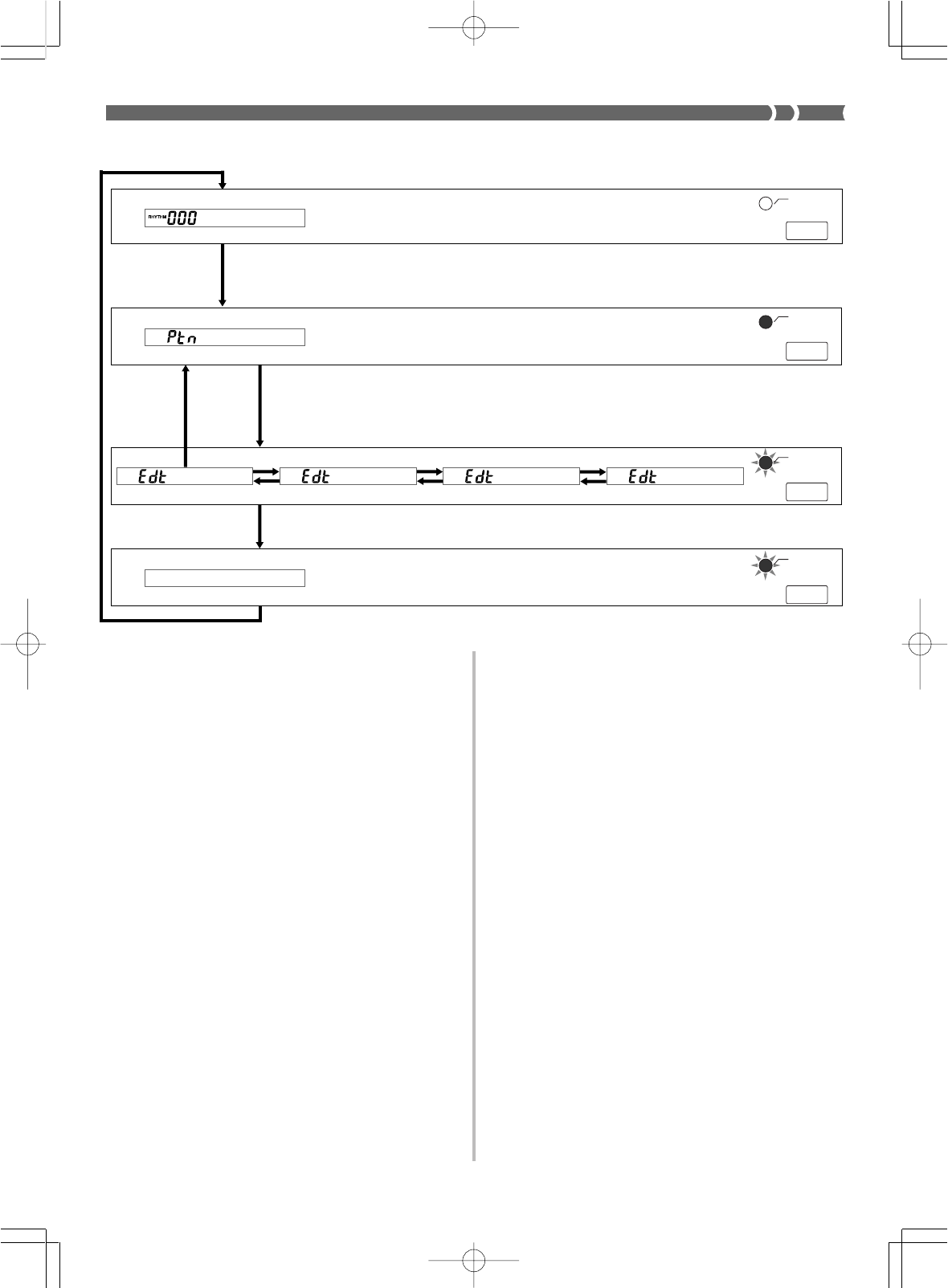
E-49
Pattern Sequencer Modes
The Pattern Sequencer has two modes: a Pattern Create Mode for
recording a new pattern, and a Pattern Edit Mode for changing the
settings of a pattern.
After you finish creating or editing a pattern, you store it in memory
and assign it a number for later recall.
The following procedure provides the basics for navigating between
Pattern Sequencer modes.
To navigate between Pattern Sequencer
modes
1.
Before turning on the Pattern Sequencer, select the
rhythm you want to use as a base for your original
rhythm.
2.
Press the PATTERN button.
• This enters the Pattern Create Mode, which is indicated when
the indicator lamp above the PATTERN button is lit. The in-
dicator “Ptn” in the tone/rhythm number area of the dis-
play (item 3 on page E-10) also indicates that the Pattern Cre-
ate Mode.
• Entering the Pattern Create Mode copies the rhythm you se-
lected in Step 1 into the Song Sequencer work area. Opera-
tions you perform with the Pattern Sequencer affect the pat-
tern that is currently in the work area.
• If the rhythm pattern you selected in step 1 is too large to fit
in the work area, the Message “Ptn Mem Full” appears on
the display for about three seconds. After that, the keyboard
enters to the Pattern Create Mode with the work area empty.
To make more room in the work area for the rhythm pattern,
delete user rhythm patterns stored in the user area (pattern
numbers 100 through 109) that you no longer need.
• In the Pattern Create Mode, you can play back the accompa-
niment pattern in the work area and even record along with
the playback. See “Using the Pattern Create Mode” on page
E-50 for full details on using the Pattern Create Mode.
3.
Press the PATTERN button again.
• This enters the Pattern Edit Mode, which is indicated when
the indicator lamp above the PATTERN button is flashing.
The indicator “Edt” in the tone/rhythm number area of the
display (item 3 on page E-10) also indicates the Pattern Edit
Mode.
• The Pattern Edit Mode screen can be scrolled between the
following three menus with the [̆] and [̄] cursor keys:
“Global”, “Element”, and “Part”. In addition to the menus,
there is also an Escape screen for exiting the Pattern Edit
Mode. Each contains parameters for making settings for the
accompaniment pattern in the Pattern Sequencer work area.
See “Using the Pattern Edit Mode” on page E-52 for full de-
tails on using the Pattern Edit Mode.
• Displaying the Pattern Edit Mode’s “Escape” screen and then
pressing the ENTER button returns to the Pattern Create
Mode in step 2.
4.
Press the PATTERN button again.
• The indicator lamp above the PATTERN button continues to
flash, and the message “Save?” appears on the display. See
“Exiting the Pattern Sequencer Mode” on page E-56 for de-
tails on how to save Pattern Sequencer data.
*
Work Area
• The work area is an area of memory where rhythm pattern data is
stored temporarily during recording and editing. After you are fin-
ished recording or editing, you can specify whether you want to
save work area contents or delete them without saving.
733A-E-051A
Unlit
Pattern Edit Mode
Pattern Create Mode
Normal
Press
ENTER.
Press PATTERN.
Press PATTERN.
Press PATTERN.
Press PATTERN.
PATTERN
PATTERN
PATTERN
PATTERN
Lit
Flash
Flash
WK-1800/1600(E)-48~57 03.7.31, 5:21 PMPage 49 Adobe PageMaker 6.5J/PPC


















